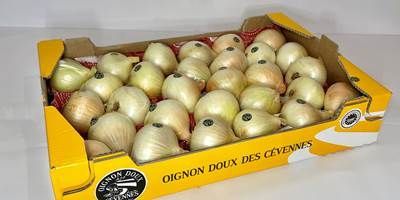
Coopérative Origine Cévennes
Tasting
to 8.8 Km in our area
The cooperative offers direct sales of sweet onion Cevennes, fruits and vegetables grown in the Cevennes (potatoes) and products derived from sweet onions, AOP soft onion Cévennes (candied), and apple reinette Vigan and the chestnut of the Cevennes and their derivatives (confit, jams, juices ...) The cooperative is open to the public and sells its products at retail: - December to June, 7/7, 10:00 to 12:30 and 14:00 to 18:00 - July to November, daily from 09:00 to 13:00 and 14:00 to 19:00 Guided tour on request.
Read more
Our recommendation
Quality local products, very welcome, easy to access.
Parc Les Accros d'Anjeau
Sport activities
to 9.1 Km in our area
En venant au parc de loisirs Les Accros d'Anjeau, vous entrez dans un grand parc d'aventures, parc accrobranche dans le Sud Cévennes et au début du Causse de Bandas, tout proche du Cirque de Navacelles. C'est un véritable parc naturel et ombragé de 3 hectares, avec plus de 140 jeux en hauteur, en passant par du vélo dans les arbres, du surf, et bien sur des grandes tyroliennes et des sauts extrêmes, de quoi faire le plein de sensations fortes et de profiter de moments fun sportifs ! Nos parcours s'adaptent à tous les âges, depuis les plus petits avec : une cabane à jeux en hauteur une cage en filet avec des balles pour courir et sauter des trampolines des parcours avec baudriers et jeux multiples. Pour les plus grands et les adultes, vous pourrez trouver aussi des parcours très physiques et très hauts. des parcours bleus, jaunes, rouges et noirs des grandes tyroliennes un Extrèm saut avec un balancier de + de 20 m... adrénaline garantie ! Un véritable choix d'activités plaisantes pour toute la famille ! Les parcours sont construits avec des équipements de dernière génération pour vous offrir une expérience ludique et sportive en toute sécurité. Des hamacs et table de pique-nique sont à votre disposition dans tout le parc, ainsi que d'une buvette et d'un snack sur une terrasse avec vue panoramique. L'entrée au parc est gratuite. Adoptez l'esprit 100% serein et zen aux Accros d'Anjeau et venez passer un moment inoubliable dans une ambiance détendue et sereine !
Read more
Our recommendation
Very well appointed for all levels; good times to spend with family.
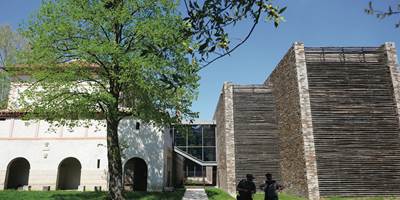
Maison Rouge - Musée des vallées cévenoles
Cultural heritage
to 27.7 Km in our area
Labellisé “Musée de France” , Maison Rouge-Musée des vallées cévenoles rassemble, dans l’ancienne filature Maison Rouge à Saint-Jean-du-Gard, quelque 10 000 objets de la vie quotidienne des Cévenols entre le XVIIIe et le XXe siècle.C’est LE musée de société consacré aux Cévennes d’hier et d’aujourd’hui .Pourquoi le châtaigner s’appelle-t-il « l’arbre à pain » ?Pourquoi le mûrier s’appelle-t-il « l’arbre d’or » ?Une collection complète d’objets exposés, mis en valeur par une muséographie de haute qualité, permettent de comprendre la vie, le savoir-faire et l’histoire des Cévennes et de ses habitants.Dans une filature historique Comme un héritage, le musée est installé dans l’ancienne filature Maison Rouge, la dernière à avoir fermé ses portes en France en 1965. Le travail quotidien des fileuses et la mémoire soyeuse des Cévennes sont magnifiquement retracés dans ce bâtiment classé aux Monuments historiques qui a bénéficié d’une rénovation remarquable et d’une extension contemporaine très réussie.À ne manquer sous aucun prétexte !Toute l'année, les audio-guides permettent des visites en anglais, allemand et néerlandais.Possibilité de visites guidées en français tous les 1ers dimanches du mois et les dimanches des vacances scolaires zone C.Des expositions temporaires sont proposées. Renseignements sur www.maisonrouge-musee.frAccès piétons : 5, rue de l'industrieAccès parking : 35, grand'rue
Read more
Our recommendation
Former spinning mill restored to create a museum of the Cévennes valleys, which traces the rich history of the Cévennes and Saint Jean du Gard. A must see .
Anambule
Sport activities
to 15.2 Km in our area
Tous deux accompagnateurs en moyenne montagne et amoureux d'un espace naturel sauvage, nous organisons et accompagnons des randonnées avec ou sans ânes : • Pour Individuel, familles, amis... Groupes constitués, centres sociaux,CE, IME, etc… • En itinérance ou en séjour au mas Corbières Vous partez sans accompagnateur, l'itinéraire est préparé (topo fourni) Les hébergements sont réservés (gîtes, chambres d'hôtes, parfois yourtes ou cabanes) • Avec ânes de bât mais également sans âne avec la préparation de l'itinéraire et les topos. Nous vous proposerons un ou deux itinéraires qui correspondent à votre demande Pour cela dites nous: le nombre de jours, le nombre de personnes, les âges des enfants s'il y en a, vos habitudes de marche… chaque itinéraire peut être aménagé : on rajoute un jour de pause en cours de randonnée par exemple... Sur les itinéraires vous aurez un descriptif rapide de la randonnée, les temps de marche, les possibilités d'hébergement pour chaque jour et les possibilités de ravitaillement quand il y en a; en général il y a 1 à 2 épiceries sommaires et dépôt de pain en cours de randonnée. Randonnées accompagnées pour un groupe déjà constitué devis sur demande.
Read more
Our recommendation
A donkey ride in the heart of beautiful wild places. Unforgettable !!
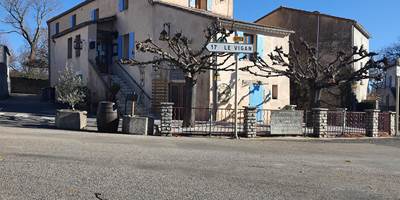
Auberge de Blandas
Restaurant
to 11.5 Km in our area
If between the visit of the Causse de Blandas and Navacelles a small feeling hungry, ask yourself here on the terrace of the hostel in the shade of mulberry trees. We meet the locals, walkers, hikers passing in that part of the department with a desire to do battle with some local specialties prepared with veal and lamb from the Causse, the trout Gravas of pélardon and 'sweet onions. Start with the countries of charcuterie plate or bone marrow gratin, then enquillez by tripoux Aveyron and boiled potatoes or grilled steak. A pélardon Altou the camp for the road and the ultimate sweet indulgence and go again to continue to enjoy the Causse de Blandas Season open every day except Sunday evening, Monday evening and Tuesday all day. From May to September open 7/7, noon and night. 4 persons / 2 rooms. picnic baskets, library, shop.
Read more
Our recommendation
Near the Cirque de Navacelles belvedere, have a good time tasting authentic local cuisine.

Restaurant La Tude
Restaurant
to 9.2 Km in our area
Nous vous accueillons dans une salle voutée, vous pourrez déguster des plats melants tradition et modernité. Les produits sont locaux (pélardon, oignons doux, pomme reinette) et la carte évolue au fil des saisons. Restaurant français, cuisine traditionnelle semi gastro, changement de carte aux quatres saisons en suivant les produits de saison et du terroir. A proximité du Grand Site de France du Cirque de Navacelles et à 10 minutes d'activités de pleine nature (randonnée à pied, à cheval, accrobranche). Ouvert tous les midis le lundi, le midi et soir du mardi au dimanche sauf le mercredi.
Read more
Our recommendation
On the road to the Cirque de Navacelles, very good tasty cuisine, made with fresh local products.
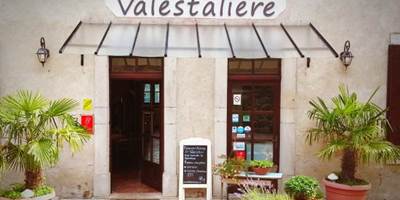
Auberge de Valestalière
Restaurant
to 23 Km in our area
In this old school founded in 1882 which welcomed more children around 50 years ago, the plates were replaced notebooks, pens covered and comfortable classrooms, a warm and authentic setting with a magnificent view the Cevennes. Traditional French cuisine and regional specialties are Mediterranean honor, always in accordance with the true taste of fresh and seasonal.
Read more
Our recommendation
Magnificent place where you can taste quality cuisine based on fresh, seasonal local products.
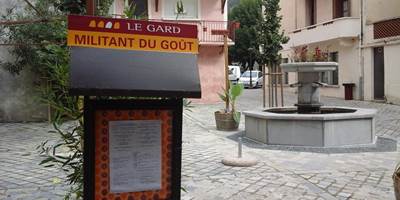
Restaurant Le Jardin
Restaurant
to 3.6 Km in our area
The Garden, located in the city center, is a warm family restaurant decorated with paintings by African artists. You are concocted a sincere cuisine where the products of the Cevennes terroir meet and accompanied by some exotic notes served with friendliness by Myriam. Specialty: Chestnut-based fondant, choice of gluten-free and / or lactose-free dishes Menus 2019: Lunch at 15.50 € (starter + main course or main course + dessert or starter + dessert) Menu at 19.50 € Menu at 28.50 € Closed from 27/01/19 to 28/02/19. Closed Sunday evening and Monday off-season (On reservation possible even on Sundays). Open every day for lunch and dinner in july august.
Read more
Our recommendation
Good Viganese address, well-mastered traditional cuisine.
Cirque de Navacelles, Grand Site de France
Natural heritage
to 12.5 Km in our area
The cirque of Navacelles is an exceptional natural heritage. Giant funnel dug by the river Vis in the mesa of Blandas. The location of the village collected 300 meters and its pit, abandoned meander, help make this extraordinary site. Since July 2013, the viewpoints of the Oaks, the Sinkhole and Cascade, on the Causse de Blandas, offer visitors a grand supervision upon the geomorphology of Navacelles and establish a respectful dialogue between Man and Earth. A building includes a restaurant, a shop-local, bar, info point with a space scénovision loop projecting a 10-minute film chronicling the natural heritage of the mesa. Two car parks. Site accessible to four forms of disability. A network of hiking trails urges visitors to discover step by step sculptural landscapes: the gorges of the Vis, the geological wonder of Navacelles, the dry stone walls ...
Read more
Our recommendation
The Cirque de Navacelles is a natural circus in the southern part of the Grands Causses. Formed by an intersecting meander of the Vis in impressive gorges between the Causse du Larzac and the Causse de Blandas, quite simply magical!

Le Mont Aigoual
Natural heritage
to 12.8 Km in our area
Read more
Our recommendation
Unmissable! The highest point in the Gard (1567 m) is a fascinating site (Aigoual, Augal in Occitan, Latin root Aiga = water) an exceptional panorama over nearly a quarter of France, is offered to the traveler!

Les gorges de la Dourbie
Natural heritage
to 11.2 Km in our area
Dourbie has its source in the Lingas massif south of Mount Aigoual, at 1 301 m altitude. It runs globally from east to west, then borders the causse Larzac (southwest) separates it from the causse Noir (northeast). It converges in the river Tarn left bank in Millau (Aveyron), at 357 m altitude. The gorges of the Dourbie are located mainly in the department of Aveyron; but a small part is in the Gard department. It is at the foot of the village of Dourbies that the river sinks into a parade with heavily wooded slopes. This picturesque route diminishes when the Dourbie approaches the village of Saint-Jean-du-Bruel (Aveyron department). After Nant, the river makes a new breakthrough in the limestone, thus separating the Causse Noir and the surroundings of the Causse du Larzac, until Millau, where the river joins the Tarn Dourbie is an abundant river, well fed by the heavy rainfall of its basin and especially of the Cevennes part of it. You can discover its gorges and canyons offering the possibility of swimming. It is also a very famous river for trout fishing . Access: From the village of L'Espérou, take the D151 direction Dourbies and Saint jean du Bruel. Photo credits: Pascal Pialot, AAPPMA la Dourbie
Read more
Our recommendation
Wild place still preserved; very pleasant in summer.
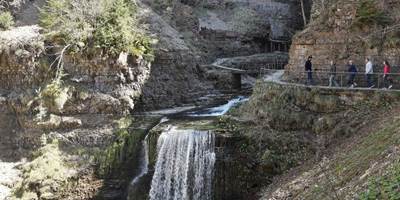
L'Abîme de Bramabiau
Natural heritage
to 14.6 Km in our area
The story of the first crossing , birth of caving on June 27, 1888At the limit of the Causses and the Cévennes, in the Aigoual massif, Happiness begins to disappear underground 5 km further, near Camprieu, and become the underground river of Bramabiau. It emerges a few hundred meters further on through a narrow crack 70 meters high and cascades out, imitating "a roaring ox".It is a part of the labyrinth of this underground course which is open to the visit thus allowing to discover calcified rooms, giant pots, swirling pillars and other marvels of concretions ... and to note that the water continues its work of sculpture. of stone. 2 tunnels and a gallery with dinosaur counterprints allow you to make a circuit with exit near the car parks.Schedule : April - May - June - September (6 visits per day) 10:30 a.m., 12:00 p.m., 1:30 p.m., 2:30 p.m., 2:30 p.m. and 4:30 p.m.July - August from 10:00 a.m. to 6:00 p.m.October 10:30 am to 4:00 pmIndoor temperature: 10 ° CBring warm clothesAnimals accepted on a lead inside the cave. Catering on site. No bank cards. COVID 19 Information: The hours, as well as the opening and reservation procedures are likely to change depending on the health crisis. Do not hesitate to contact them for more information and to book your entrance tickets.In October until the last day of the All Saints holidays: open every day from 11:30 am to 3:45 pm. Health pass compulsory.
Read more
Our recommendation
Grandiose! The abyss of Bramabiau is a cavity from which emerges an underground river Happiness ... Magnificent waterfall and fascinating guided tour ...
Parcours Land-Art "les Balcons de l'Aigoual"
Natural heritage
to 12.3 Km in our area
La Filature du Mazel, artistic and cultural factory, the Community of Communes Causses Aigoual Cévennes Terres Solidaires present LES BALCONS DE L'AIGOUAL, Land Art course on Mont Aigoual.“Become one with nature”: Walk Mont Aigoual enjoying the beauties of a striking Land Art course, contemplate the wonders of Mont Aigoual along a 7 km walk enhanced with works of art made with the materials natural, surrender completely to the serenity of a unique moment ... You will come back grown and soothed from this walk!This artistic route starting from the Prat-Peyrot pass is free, the works will remain on display throughout the year. Length of the route (loop): 8 km; Elevation: 150 m; Signposted route. Provide suitable shoes and clothing.• The artists of the works already on site:Marie Hélène Richard, Aurélien Dupuis, Céline Pialot, Fiona Paterson and Donald Buglass, Yoann Crépin, Guth Joly, Xavier Rèche and Marie – Hélène Richard, Paula Anke, Marie Gueydon De Dives, Marc Limousin, Alain Bernegger, Raphaël Daynié.• The artists 2021: Xavier Reche, Steven Onghena, Gilles Bruni and Céline Pialot in residence in Trèves (realization of a participatory work with the school and the inhabitants from June 17.) Consult the 2021 brochure Les Balcons de l'Aigoual in attached file!The Atelier des Monts brumeux association offers, as part of the Land-Art course, guided tours, plant-based paper making workshops, and Land-art activities around the course. Speakers: Céline Pialot and Ophélie Pauchet. Contact: +33 (0) 6 01 07 65 43. All workshops are on registration. https://celpial.wixsite.com/celinepialot/l-atelier-des-monts-brumeux.Please note, for safety reasons, this route is prohibited during snowy periods!
Read more
Our recommendation
At the heart of the Cévennes National Park which spans three departments, Lozère, Gard and Ardèche, this route is a great way to raise awareness among diverse audiences about the significant issues of sustainable development, the place of man in the landscape and the need for an artistic dimension inscribed in nature.
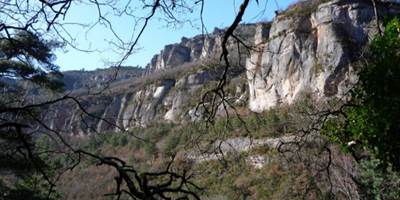
Les gorges du Trèvezel
Natural heritage
to 16.5 Km in our area
Trevezel marks the boundary with the Gard department, of which it adjoins 4 communes (Revens, Trier, Lanuéjols and Causse-Bégon). This site marks the geographical separation between the Black Causse and the Causse Bégon. You will discover its gorges and canyons, its dolomitic cliffs, its caves and avens appreciated by speleologists. Access: From the village of Camprieu, take the D157 towards Trier.
Read more
Our recommendation
You will be able to discover there gorges and canyons offering the possibility of swimming and trout fishing, its dolomite cliffs, its caves and sinkholes popular with speleologists. Beautiful preserved natural site!
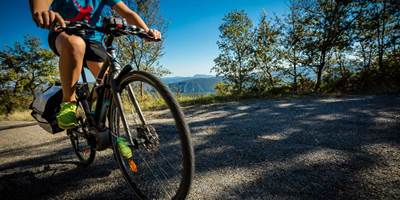
Cigale Aventure
Sport activities
to 3.6 Km in our area
Specialist of cycling and nature in Languedoc and Cévennes, Cigale Aventure takes you to discover the most natural sites, from 1 to 99 years. Get on your bike, put on your harness, your suit, go! Some examples : Electric bike, easy bike: 1/2 day rental: from 33 € day rental: from 44 € Mountain bike, leisure or sports: 1/2 day rental: from 17 € day rental: from 22 € Canyoning on Mount Aigoual: "discovery" 1/2 day: from 38 € (adults), from 34 € (-12 years) "canyon sensations" day: from 55 € Kayak rental: several courses from 6 years From € 20, children's discounts Visit our website to find all our activities. Opening of the Boutique: In season every day, out of season, consult the answering machine telephone. Spoken languages • English
Read more
Our recommendation
Very warm welcome with a motivated, experienced and available team; do not hesitate to book all your sports activities during your stay in our beautiful region.
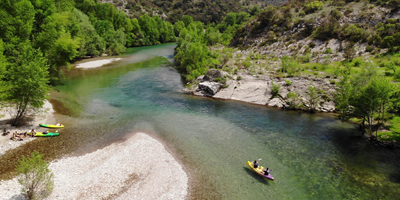
Canoe Montana
Sport activities
to 17.9 Km in our area
Canoë Montana vous propose 3 parcours en canoë ou en kayak dans la partie la plus belle et la plus sauvage des gorges de l'Hérault .Vous pourrez effectuer cette descente en kayak 1 place ou en canoë 2, 3 ou 4 places. Canoë Montana vous propose également la location de vélos à assistance électrique sur la base d'Agonès et à Saint Jean de bueges . La base canoë Montana se trouve entre Ganges et Saint Guilhem le désert à 25 minutes au nord de Montpellier, 30 minutes de Nîmes, 40 minutes d'Anduze. Située à peu de distance des plages, 1 heure d'Agde, de Vias, de Marseillan-plage, de Palavas et de La grande Motte notre base vous accueille tous les jours de début avril à fin octobre. Conditions requises pour effectuer une descente, être âgé au minimum de 6 ans et savoir nager 25 mètres.
Read more
Our recommendation
Canoë Montana offers 3 courses in the most beautiful and wildest part of the Hérault gorges, every day from April to the Halloween holidays. So get started and book your course!
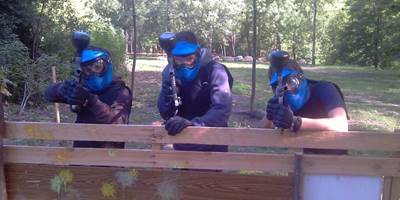
Paintball Ceven'
Sport activities
to 2 Km in our area
Paintball CEVEN 'offers a relaxing day on his wooded and shaded land in the heart of the Cevennes at the entrance of Breau near the Museum of Toys and Camping Peloux With family or friends, share a sport of nature ... Thrills! From the age of 8. Land & standards to secure full facilities. Booking is recommended. Shot on target to be the engine disabled. Rental includes: - Complete equipment launcher - Thermal Mask (anti-fog) - Chest - Gloves - Round shot - Unlimited Air - Insurance - Coaching
Read more
Our recommendation
For enthusiasts, a warm welcome, come and let off steam ...
Arbor&sens
Sport activities
to 10.4 Km in our area
Nous proposons nos actions d'éveil et de bien-être : Escapades autonomes et captivantes en famille ou entre amis et Bivouac Aventure, Exploration ou Liberté au sein d'un espace naturel semi-sauvage et son parc d'éveil ludiques, d'où sont proposées d'inoubliables immersions forestières crépusculaires et nocturnes.Attentifs aux besoins d'épanouissement de votre joie de vivre.Nous proposons nos actions d'éveil et de bien-être multi-générations : en mode Escapades autonomes et captivantes en famille ou entre amis.Aux alentours de l'Aigoual, dans divers riches milieux de vie des vertes Cévennes Méridionales. (location de kits interactifs, pour tous).Et en mode " Bivouac Aventure, Exploration ou Liberté ". Au sein d'un espace naturel semi-sauvage et son parc d'éveil ludiques, d'où sont proposées d'inoubliables immersions forestières crépusculaires et nocturnes animées par Cyril, Guide-interprète Nature.
Read more
Our recommendation
Exploration within a semi-wild natural space and its playful awakening park, from which unforgettable twilight and nocturnal forest immersions are offered. To experience.
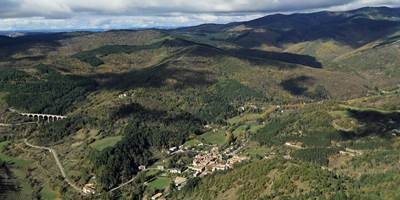
Espace Ceven'Trail N°7
Tourist itineraries
to 11.1 Km in our area
For this circuit on the heights of Alzon, take advantage of the 2.5km prologue on the small road to Le Villaret to warm up in peace. From the start of the path at the crossroads of the path of La Goutte, 400m of difference in altitude awaits you in less than 2km of ascent! But if the effort is there, what a treat for the eyes on this magnificent draille carved on a schistous spur. A loop starting from Alzon, count between 1h25 and 2h35 for 12.8 km and 435 metres of difference in level. © Espace Ceven'Trail - TopoTrail - Loop 7 - Blue level
Read more
Our recommendation
The Ceven'Trail space: trail circuits for all ... 20 permanent marked trails, from easy to difficult. No less than 330 km of marked paths and trails are available to you to discover this territory ranging from the Cirque de Navacelles to the Orgon waterfalls in the Cévennes National Park. Do not forget each year at the beginning of March the Ceven'Trail races in the country of Vigana, the next edition will take place on March 7, 2021.
Les Moulins de la Foux
Tourist itineraries
to 13.6 Km in our area
From Le Vigan, take the direction of Millau. After 1.5 km, turn left towards the Cirque de Navacelles. Go as far as Blandas. From there, there are 3 possible ways to get to the resurgence of the Moulins de la Foux. Leaving from Vissec: A round trip in the dry meanders of the Vis. Duration 1h45. Distance: 8.4 km Start at La Plonque, then cross L'Ubac, La Pause, Sous bos Nègres to Les Moulins. The harsh and windy climate and the very calcareous soil have forced the plants to develop deep roots in order to draw water. From Blandas: Round trip. Duration: 2h15. Distance: 8.8km Departure from the church square in Blandas, take the street of the water tower, then go through the Cross. Caussenard environment up to the Rocher du Loup, then take an asphalt road for 700m up to the hairpin bend. Then continue on the route description below. Drive down: Round trip. Duration: 1 hour. Distance: 2.9km Drive down into the Cirque de Navacelles for 4km to a hairpin bend where you can park. Typical Mediterranean flora: thyme, Montpellier maple, wild asparagus... The further you go down, the more the vegetation changes and you will appreciate the freshness of the Lebanese cedars. As you approach the river, the freshness intensifies even more, the trees are more vigorous and you can even find ferns. Suddenly, in a rumble, the screw emerges from the entrails of the mountain. The flow is abundant and allowed the mills, several times destroyed by the floods and then rebuilt, to operate until the beginning of the 20th century.
Read more
Our recommendation
Small hike accessible to all; the more you go down, the more the vegetation changes and you appreciate the freshness of the cedars of Lebanon. As you approach the river, the freshness intensifies even more, the trees are more vigorous and there are even ferns. Suddenly, in a roar, the Vis arises from the bowels of the mountain .... Magnificent!
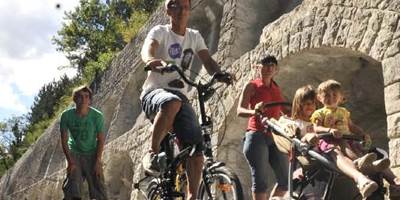
Voie Verte La Promenade du Viaduc
Tourist itineraries
to 4.3 Km in our area
The route runs for 3.5 km near the villages of Molières-Cavaillac, Bez-et-Esparon and Arre. The route follows the old railway line Tournemire (Aveyron) - Le Vigan (Gard). The walk takes in the mountainous relief of the Cévennes, and progresses through particularly luxuriant vegetation. This route runs along the large karstic plateaus of the Causse de Blandas on the right bank of the Arre valley which separates them from the granite massif of Linguas and Mont Aigoual. You will benefit from privileged observation points on the vents of Bez, Brun, Rognes and the Calles caves. The Viaduct walk also offers splendid views over the Cévennes valley of the river Arre, dominated by the Rocher d'Esparon. To discover: the remarkable Eiffel-type metal bridge at Lavassac, with a span of 80 metres and a weight of 418 tonnes of steel !
Read more
Our recommendation
The Viaduct Promenade: The route runs for 3.5 km near the villages of Molières-Cavaillac, Bez-et-Esparon and Arre. The route follows the old Tournemire (Aveyron) - Le Vigan (Gard) railway line. While rushing into the mountainous terrain of the Cévennes, the walk progresses in the middle of particularly lush vegetation. To do with the family, no difficulty.
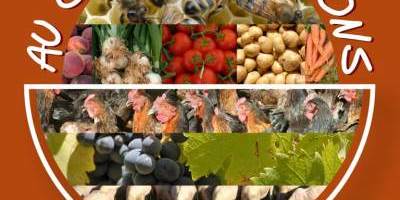
Boutique Paysanne au gré des saisons
Tasting
to 13 Km in our area
Shop Paysanne is managed by a group of farmers and artisans, offering consumers a range of local products through direct sales. Here local farmers sell fresh or processed by them products. They welcome you to turn and you have the fruits of their labor. Directly from our farms, so you will find seasonal produce: vegetables and fruits, pork, lamb, veal and poultry, trout, honey, jams, olives and olive oils, organic breads, eggs, juice fruit, wine, goat cheese and sheep ... Farm products: Cévennes sweet onions - vegetables - jams - onion confit - fig chutney .. for sale on site. Operation: Low season (November to March): 9 am-12:30 and 3:30 p.m. to 6:30 p.m. High season (April to October) from 9am to 12:30 and 16h-19h30 Friday at 18:30 in July and August. The rest of the year by appointment.
Read more
Our recommendation
A shop offering a wide variety of local products, a warm welcome and the restaurant next door.

La Ferme de Valbonne
Tasting
to 10.8 Km in our area
In a typical hamlet of the twelfth century, Valbonne offers a personalized welcome with free tasting of chestnut products and many explanations of the chestnut and its culture in organic and biodynamic agriculture. Manufacture of chestnut jams, chestnut cream: plain, with pieces, with orange, rum, praline, chestnut flour, chestnut, chestnut au naturel, chestnuts in syrup, breakfast with chestnut, shortbread, soup of pumpkin with chestnut. In season: chestnuts and fresh chestnuts. Transformed garden products: sweet onion jam, gherkins, spicy oil, hot peppers. Direct sales on the farm from 11 am to 7 pm, 365 days a year.
Read more
Our recommendation
You are welcomed, 7 days a week from 10 a.m. to 7 p.m., a free tasting on site (organic chestnut cream and all chestnut products ...)
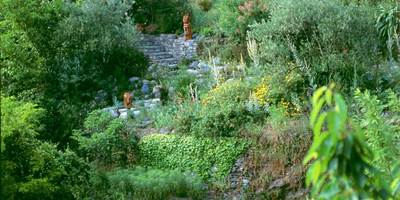
Le Jardin des Sambucs
Cultural heritage
to 9.7 Km in our area
Welcome to this free and happy garden! It invites you to stroll at your own pace at the foot of the stone trees, to take a nap on the shaded benches, to approach the water points that punctuate the walk or to drink a hibiscus while chatting with friends.The gardeners, Agnès and Nicholas will be happy to welcome you and share with you the history of their garden, which changes over time.Be careful, their passion may win you over, they like to transmit their desire to be in the garden.Patients like gardeners!As you know, in the context of the Covid-19 epidemic, a health charter was established allowing the reopening of parks and gardens in order to ensure the best protection of visitors and gardeners.Rules must be observed, they apply to the reception of visitors and when visiting the garden.A direction of visit avoiding crossings is desired. Disinfection every two hours of the equipment where the hands could be posed, obligatory mask for the gardeners.At Les Sambucs, it's impossible not to cross paths on the labyrinth of paths, no strolling on the nap benches, forget the cushions, the children's area, the library, the cabinet of curiosities where hands and plants are fun. smell with the eyes, for the croq'jardin it's complicated ...During this "seasonal parenthesis" we continue to take care of the garden, the planters sow trees, herbs, collect flowers, leaves for new drinks, tastings, plants for use are installed, the vegetable gardens are enlarged, the gardener chooses the herbs to preserve, builds a new “musical” bench, installs a new water point, finishes the “little nursery for next year”."The mold flowers" homage to Hundertwasser, the mosaic cave "do not wake up the sleeping monster" are finished, the exhibitions and workshops planned are postponed to next spring.Thank you for your understanding and your patience, we will be delighted to welcome you to the garden that you love so much.The lodging and the two guest rooms of MLou are open and welcome you in the best sanitary conditions. COVID 19 Information: The hours, as well as the opening and reservation procedures are likely to change depending on the health crisis. Do not hesitate to contact us for further information. Opening of the Garden on May 1, 2021 subject to current sanitary conditions. MAY :Monday, Thursday, Friday, Saturday, Sunday and public holidays from 10 a.m. to 6 p.m. JUNE : The garden is open every day from 10 a.m. to 6 p.m.We suggest you taste the croq'jardin from Thursday to Monday by reservation: 0652707855JULY AUGUST :Open every day from 10 a.m. to 7 p.m. No Croq'jardin on TuesdaySEPTEMBER:In September (from 1 to 19) the garden is open from Thursday to Sunday, from 10 a.m. to 6 p.m., closed Monday, Tuesday, Wednesday. No "sanitary pass" to visit the garden because less than 50 people at a time. Le Croq'jardin can be booked before 10 a.m. at 0652707855 from Thursday to Sunday. The "sanitary pass" is requested.
Read more
Our recommendation
A remarkable garden in the Cévennes, spend a timeless moment in the heart of this atypical garden, free and joyful ...
Musée Cévenol
Cultural heritage
to 3.8 Km in our area
Housed in the old district of "le vieux pont", the Cevennes Museum preserves and promotes local historical heritage. terracotta, wood, stone, wool, silk represent the historical engines of crafts and industry in the southern Cévennes. Open since 1963, this museum exhibits on three floors a rich collection of objects evoking: -the life of the people of the limestone plateaus and the valleys, - Ancient crafts, - The life of the writer André Chamson academician.In April, May, June, September and October: Wednesday to Sunday from 10h to 12h and from 14h to 18h Open exceptionally on Easter Monday and Whit Monday In July and August: Every day except Tuesday from 10h to 13h and 15h to 18h30 Closed 1st MayGroup by appointment.
Read more
Our recommendation
Created in 1963, in a former silk mill, the Cévenol Museum presents the Cévennes civilization on three levels. Very informative, not to be missed.
Le Musée de la Soie
Cultural heritage
to 23.5 Km in our area
The museum retraces the sericultural past in the Cévennes and endeavors to highlight a heritage that participated from the 13th to the 20th century in the Cévennes identity. St-Hippolyte-du-Fort was once the seat of the Cévennes silk controllers. From the breeding of the caterpillar to the manufacture of the fabric, these are all the stages of the transformation of silk, the traditional but also current silky techniques used in the region, which are presented at the museum. The visit : The museum's living silkworm exhibits the different life stages of the caterpillars (silkworm breeding from the end of April to October). Spinning and working with silk thread: weaving and knitting. Archival video films retracing the world of sericulture in the 1950s are screened during the visits. The museum hosts the sales area for the creations of the “Soierie des Cévennes” made at the Gréfeuilhe workshop in Monoblet. The following are also offered for sale:colorful silk scarves, small original accessories, jewelry, wipers, headbands… bags of cocoons, garnished heather, mulberry blackberry jam, books on silk, postcards… Guided tour, by appointment. Hours : 10.30 a.m. - 12.30 p.m. and 2 p.m. - 6 p.m. - Closed Monday except public holidays July & August: open every day Closed from January 1 to February 10 and December 25, 2020.
Read more
Our recommendation
The History of Silk: The living silkworm in the museum presents the different life stages of caterpillars (silkworm breeding from late April to October). Spinning and working with silk thread: weaving and knitting. Archival video-films retracing the world of sericulture in the 1950s are shown during the visits. Worth the detour !
Village de Valleraugue
Cultural heritage
to 10.2 Km in our area
The earliest records of Valleraugue date back to the 13th century. The Romanesque bridge spanning the Hérault is one of the witnesses of this ancient era. Over the centuries, the village has expanded and takes on the appearance of a small town in the nineteenth century with a population exceeding 4,000 inhabitants. It is then a small industrial city producing silk and milling the thread in more than 17 spinning mills spread over the Hérault or Clarou. The traces of this period profoundly mark the architecture with raised houses, magnaneries to accommodate the education of the silkworm, many chimneys that emerge from the roofs and old mills with their large semicircular windows. In addition to the traces of silk, the small vernacular heritage testifies to the important agricultural activity of this part of the Cevennes. Village ovens, clèdes, mazets, bridges spanning the valleys all a know-how in river stone that gives its character to the village and its hamlets. The drailles, the sheepfolds and transhumance tell the agropastoralism that rhythm the seasons. Béals, pavements and gourgues tell all the work of drainage and water capture to feed the mills yesterday and fields of sweet onions today. In this small city, cultural heritage is also very present. From the twelfth century with the founding of the Abbey of Happiness through the Camisard War and the resistance Maquisarde, Valleraugue is part of the history of the Cevennes. She saw the birth of a jewel of celebrities with among others Laurent Angliviel of Beaumelle, General François Perrier, Jean-Louis Armand Quatrefages de Breau, Germaine Dieterlin ... Nowadays, Valleraugue is also a recognized tourist center with the practice of outdoor sports such as skiing at the Prat-Peyrot resort, fishing in the Hérault river and hiking, in all its forms on foot, on horseback , by bike, mountain bike and in all seasons.The climb of the 4000 Marches is the most famous, it starts from the village and impresses a path all along a ridge to the top of the Aigoual with a difference of more than 1220m. Points of interest: Landscape: The richness and the vegetal diversity of the slopes of the Aigoual attract herbalists, botanists or simple walkers. In this beautiful landscape, practice all types of hiking, walking with the classic Cévennes, the 4000 Marches and its 1200m vertical, but also with donkeys, horses, mountain bikes, bikes, snowshoes. In winter, the Part Peyrot ski resort welcomes alpine and Nordic skiers. Discovery of the Aigoual massif with the development of the 4 seasons nature pole. Agriculture and pastoralism: Pélardon, sweet onion of the Cevennes. The great agricultural activity of the town, like those of the South Cévennes, is the cultivation of sweet onion Cevennes, AOP, and the sector has also recently obtained the label "Remarkable Site of Taste" for this product and its production which marked the landscape. The community has flocks of ewes, most of which still practice transhumance, as well as herds of goats which give the famous Pélardon des Cévennes. For tourist information, the Tourist Office Mont Aigoual Causses Cévennes, Country House of Valleraugue, is at your disposal. Contact form
Read more
Our recommendation
Pretty little flowered and welcoming Cevennes village, Valleraugue is nestled in the valley at the confluence of the Hérault and Clarou rivers. On an area of 8,735 ha, the town extends over more than 1000 m of height difference between its highest point, Mont Aigoual (1567 m) and the village (357 m).
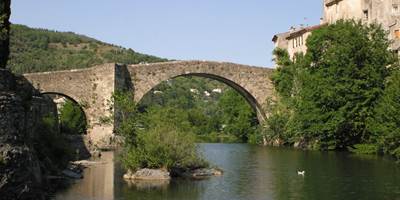
Le Vigan
Cultural heritage
to 3.6 Km in our area
If the first traces of settlement date back to the 3rd century BC, Le Vigan notably gained importance in the Middle Ages with the founding of a priory in 1053 . Entrusted to the Benedictine monks of the Abbey of Saint-Victor-de-Marseille, the existence of a hospital attests to the central role of the town in the region. Today, the heart of the city offers a narrow set of checkered alleys with names evoking this old city: rue du Pouzadou (du petit puit in Occitan), rue du Four or even rue de la Boucherie. Marked like the whole of the region by the religious conflicts of the 16th century, the city experienced a prosperous period in the 17th century. Under the influence of the lights and enriched by the flamboyant beginnings of the French textile industry, many mansions were created. The Château d'Assas, which today hosts the intermunicipal media library and numerous events, is one of the finest examples. In a central position, rich in its services and with a quality cultural agenda, Le Vigan is a must-see during your stay but also a practical starting point for discovering the region. The most curious can also stop at the Cévenol Museum and travel back in time from prehistoric times to the present day in order to discover the Cévennes and the Cévenols in a different way. Classified Green Station, the municipality of Vigan is committed to the environment and more responsible tourism. You can find on our site all the practical information to organize your stay. Le Vigan is easily discovered on foot !! Do not hesitate to download the brochure for more information.
Read more
Our recommendation
In a central position, rich in its services and with a quality cultural agenda, Le Vigan is a must-see during your stay but also a practical starting point for discovering the region. The most curious can also stop at the Cévenol Museum and travel back in time from prehistoric times to the present day in order to discover the Cévennes and the Cévenols in a different way. Classified Green Station, the town of Vigan is committed to the environment and more responsible tourism.
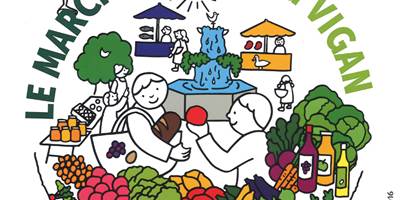
Farmer's Market
Festivals and events
to 3.6 Km in our area
From May 14 until mid-October. Every Tuesday morning. Farmers present: market gardening, fresh trout and smoke, vegetable plants, grapes.
Read more
Our recommendation
Small Farmer's Market: From May until the end of September. Every Tuesday morning. Farmers present: market gardening, fresh and smoked trout, fruit, local cheeses ...
Parcours de santé du Fontaret
Tourist itineraries
to 10.8 Km in our area
From Vigan (20km journey), take direction Millau (D999), 1.5 km further, turn left to Avèze (D48). Cross the village and continue until Montdardier (7km ascent). Take the D113 to Blandas (7,5km). In the village of Blandas, follow direction Vissec (D113) after 1km on the right side of the road is the parking lot and the beginning of Fontaret fitness trail.
Read more
Our recommendation
Playful fitness trail in the heart of nature that accepts our dog friends.
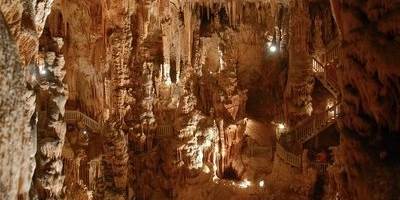
GROTTE DES DEMOISELLES
Natural heritage
to 18.5 Km in our area
50 mètres de hauteur sous plafond, 120 mètres de long, 80 mètres de large : son surnom de cathédrale des abîmes sied à merveille à cette grotte fabuleuse situé sur le plateau de Thaurac. Découverte en 1884, elle a son lot de légendes, comme en témoigne, entre autres la stalagmite de la Vierge à l'Enfant.
Read more
Our recommendation
Where are we?
1448 Départementale 272b, Le Mas De Ribard, 30120 BRÉAU-MARS
Itinerary
